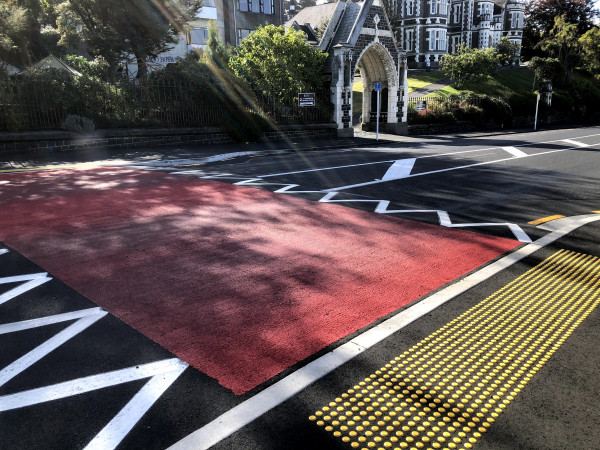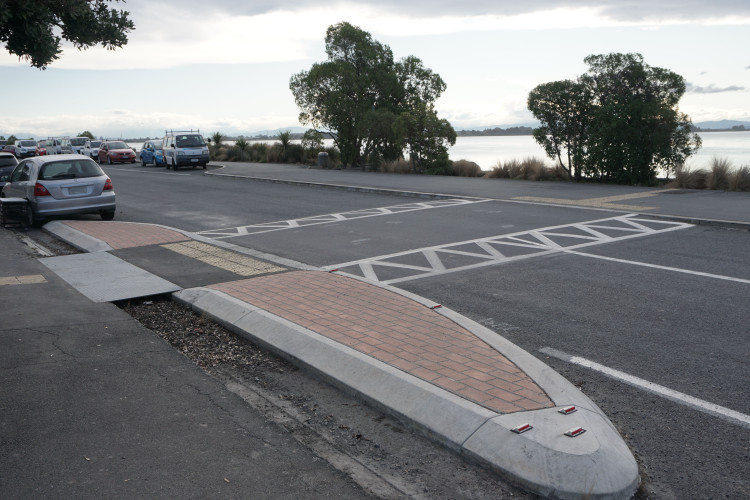Courtesy crossings are usually made of bricks or paving or raised above the level of the road. Courtesy crossings are intended to facilitate eye contact between pedestrians and drivers resulting in a mutually negotiated position over who goes first. However, this can create uncertainty between road users as to who has the right of way, which can be very uncomfortable (or unacceptable) for some pedestrians.
I don't really like to eyeball a driver so I prefer zebra crossings and traffic signals. Usually I can work out my own way to go that has the crossings I like but sometimes it means a much longer walk which is hard if I'm trying to get somewhere in a hurry. |
Courtesy crossings should provide a place where drivers can stop safely to allow pedestrians to cross. Drivers are not required to stop at courtesy crossings, however the official New Zealand road code recommends that drivers are courteous to pedestrians using or waiting to use a courtesy crossing.
The official New Zealand road code
An example of a courtesy crossing is shown in the photo below.

Courtesy crossing, Dunedin. (Photo:Ann-Marie Head)
|
Courtesy crossing |
Pedestrian platform |
|
|
 |
|
Courtesy crossings are intended to facilitate eye contact between pedestrians and drivers resulting in a mutually negotiated position over who goes first. |
On their own pedestrian platforms provide a focus for pedestrians to cross, however pedestrians must still give way to vehicles. |
|
Traffic volume less than 7500vpd (could be higher if a median refuge is provided and an alternative crossing provided nearby) |
Traffic volumes less than 3000vpd |
|
Vehicle operating speeds very low, at most 30km/h, ideally 20km/h or less. The lower the speed the more effective the crossing as vehicles are going to slower so are more likely to be courteous to pedestrians wishing to cross. |
Vehicle operating speeds less than 50km/h (the platform should be designed to slow vehicle speeds to 30km/h) |
|
Likely to be found on Activity Streets, Main Streets and Civic Spaces where pedestrian volumes are high |
Likely to be found on Local Streets and Activity Streets where the pedestrian volumes are low |
|
Ideally on a platform with steep approach ramps to reduce vehicle speeds |
On a platform with approach ramps to reduce vehicle speeds |
|
Crossing colour/texture should contrast with the road and footpath to indicate both users are guests over the crossing |
Crossing colour/texture should contrast with the footpath to indicate that pedestrians do not have priority and ideally be the same material as the road. |
As courtesy crossings are not obvious to both pedestrians and drivers, their use is generally discouraged except where the pedestrian volumes are very high and vehicle speeds are very low. Courtesy crossings may be appropriate in locations where there are alternative priority crossing/s located nearby as this provides route choice.
PNG: Principles of Safe, Obvious and Step-free (SOS)
Check whether a courtesy crossing is a suitable treatment for your site by referring to:
PNG: Crossing selection guidance
Courtesy crossings can be combined with other infrastructure such as kerb extensions and pedestrian refuges.
Courtesy crossings are not specifically mentioned in the TCD Rule. However, the following rules about traffic control devices apply.
An RCA may provide signs, markings, surface texture or raised platforms or kerb extensions and traffic islands or other techniques to guide a pedestrian to a place at which to cross a roadway (TCD Rule, 8.8(4)).
If an RCA installs a device as above that does not require a driver to stop their vehicle to allow a pedestrian to cross the roadway, the road controlling authority must ensure that the device conveys a clear and consistent message to road users (TCD Rule, 8.8(5)).
Land Transport Rule: Traffic Control Devices 2004
Courtesy crossings should feature the following elements:
Design details for courtesy crossings should be consistent with each element including provision of tactile indicators and handrails. More information about these design elements can be found in the following crossings:
Table: Design elements for courtesy crossings
|
Element |
Requirement |
Additional information |
|
If crossing includes a platform: Platform height, length, gradients, ramp markings, platform signage |
As per pedestrian platforms |
Note, courtesy crossings require vehicle approach speeds to be 30km/h or less so platform ramp gradients need to be designed to support this requirement. |
|
Surfacing / colour |
The platform surface should be clearly distinguishable from the footpath and the roadway to indicate that neither pedestrians or vehicles have priority and to encourage courteous behaviour. |
Also refer to Roadway art guidance found in the |
|
Tactile indicators |
Warning indicators are required and directional indicators may be necessary. |
See RTS 14 – Guidelines for facilities for blind and vision impaired pedestrians [PDF, 1.6 MB] |
|
Lighting |
In accordance with AS/NZS 1158.3.1: 2020 |
[1] Corben, B. (2020). Integrating Safe System with Movement and Place for Vulnerable Road Users(external link), Austroads, AP-R611-20, p19